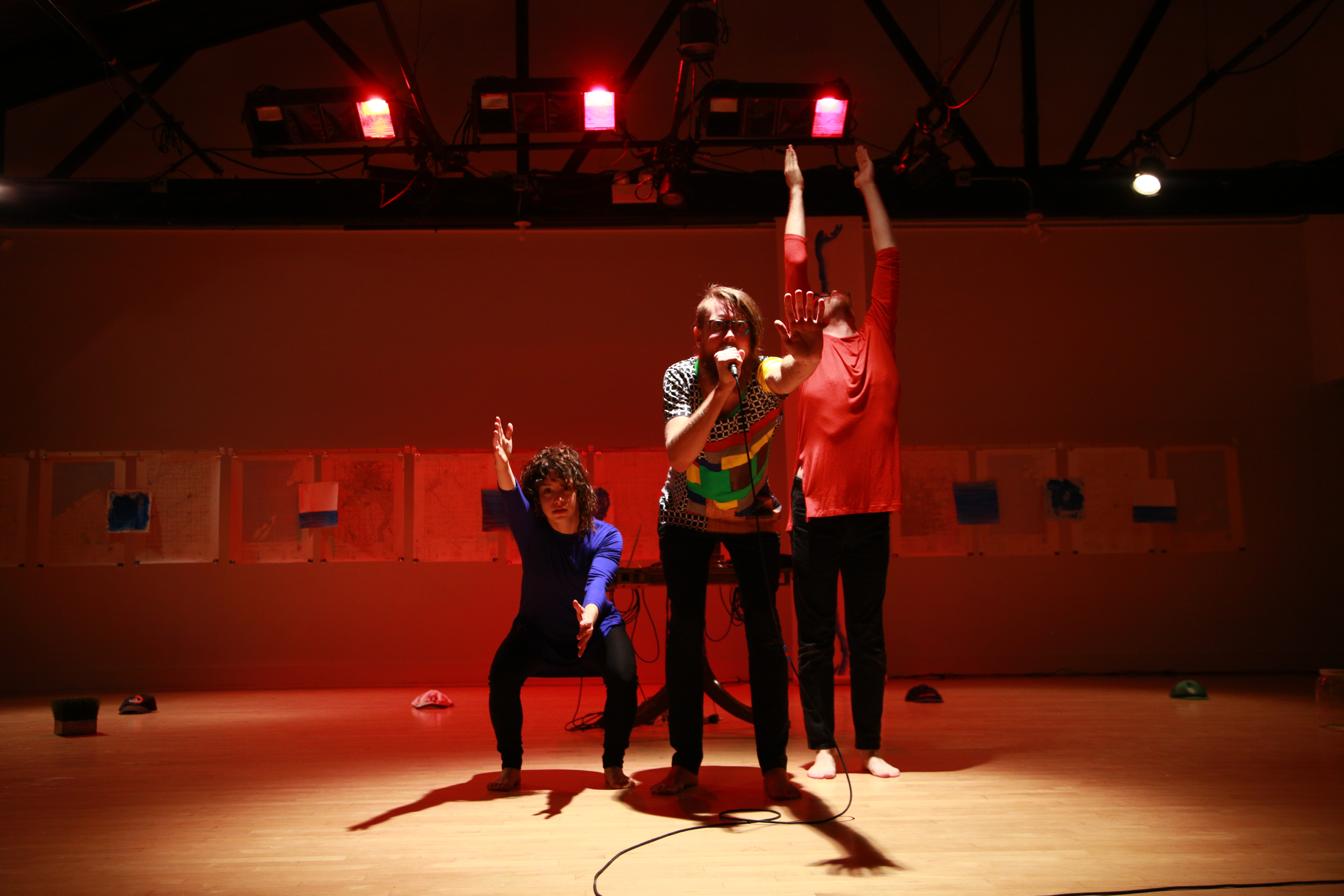CHICAGO — The New Prairie School, an evening-length performance by composer, writer, and performer, Corey Smith, along with fellow performers and collaborators Ethan T. Parcell and Claire Saxe, debuted last weekend at Links Hall. As the title suggests, the work was partially inspired by research around Frank Lloyd Wright and the Prairie School of architecture of which he is most famously associated however this performance went all over the proverbial (Midwestern) map.
The New Prairie School was composed using good old chance operations, whereby set sections of material, each represented in this case by a tiny ball in a tiny bingo cage, were chosen at random to make up the night’s performance. Smith actually calls each section a “knee” explaining that a knee is a joint, something that holds two different structures together. (I’m paraphrasing but that was the gist).

In fact, the printed program for the evening (designed by J. Clay Gonzalez) gives almost no information about the performers or designers, and is instead entirely dedicated to a poetic list of possible knees for the evening like “Phone poles” written by Saxe, “Leftover face paint” written by Parcell, and Smith’s “The Toledo War in 1 minute.”
Out of 19 devised knees, five were selected by spinning the bingo cage. I suspect there are aspects of the show that are always performed, no matter chance’s whimsy, like the show’s awesome introductory song that I want to call “I Want it All” (again, no conventional program notes), a sweet little song with the refrain “dance, music, sex, romance”, and the final text delivered by all three performers describing various anecdotes about what it might mean to be Midwestern.
Nevertheless, the theatrical magic created by chance operations rarely disappoints because it keeps things fresh for the performers and leaves the appropriately impressed audience asking themselves, “How did they do that?” The only grudge I have against this particular usage was an awkward break in momentum between sections. Their rather “aw shucks” humility — now that is Midwestern — during those cage-spinning breaks was a bit incongruous with a clearly well-rehearsed, well-researched presentation of content. If I assume that their “real” personalities were being performed in those moments, then what did it mean that their personas changed to a rather deadpan, controlled neutral during the “actual” performance? Which leads me to ask: who are these people and what is their relationship to Frank Lloyd Wright?
I’m not worried about these questions in an intense, existential way. The nature of this style of performance — a style I will characterize as “performance lecture”: a quasi-didactic technique where the performers ramble off extensive scientific and historical research about a topic they don’t entirely care about juxtaposed with quirky instruments, old-timey props, and elementary dance breaks — although clever, leaves me searching for some way to position these performers in real time in the real world. They have created a laboratory bubble on stage (with a beautiful set design by Perry Maddox and lighting by Giau Truong) where computers, microphones, soundboards and speakers happily coexist with human bodies and an empty birdcage. But this is not a scene from real life. This is a constructed space; the trio performs its material with stylistic detachment. Smith even admitted that he doesn’t care about Frank Lloyd Wright, and that he just wants to “steal his ideas.” So, if they don’t really care about the content of the research then what do they care about? And how do they feel about the content they are performing?

These are over-simplified questions. Smith spent four years making this piece; of course they care. I think they care about uncovering the history of the Midwest and their ancestry within it as a means to eventually reinvent it. Dare I say they might even be trying to “rebrand” the Midwest? They also seem to care about enchanting their audience, making them laugh at slapstick antics (like shoving speakers in each other’s mouths), having the audience sing along to original music, and surprising them by doing a dance with just their ribcages and calling it a “song.”
They also care about making a good show. Refreshingly, there were no loose or unconsidered ends in this work. All three performers, Smith and Saxe especially, had excellent stage presence and worked terrifically well as an ensemble. The music and sound design (by Smith) was particularly fantastic and Smith is an excellent front man. If only these performers put half as much investment in the exploration of choreography and the potential for more complex physicalities as they have in the rigorous historical research and writing of the piece, we might have had a spectacular show.
All in all, this 90-minute piece somehow felt incomplete. Aside from the fact that it was too long, it was as if we never heard a complete sentence (although we heard many). I’m left feeling unclear about the performers’ point of view, their charge for the future, and the “moral of the story,” so-to-speak. I don’t necessarily need everything to be all wrapped up, but I would like to feel like we arrived at some degree of enlightenment. One of the final things Smith said was, “What if I told you I had no more questions?”
I guess my response is, “OK. So now what?”
— Joanna Furnans
